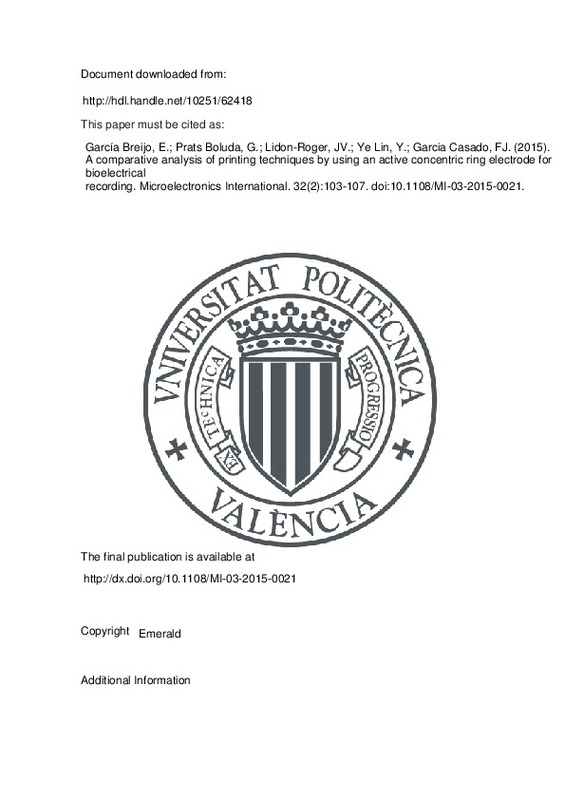JavaScript is disabled for your browser. Some features of this site may not work without it.
Buscar en RiuNet
Listar
Mi cuenta
Estadísticas
Ayuda RiuNet
Admin. UPV
A comparative analysis of printing techniques by using an active concentric ring electrode for bioelectrical recording
Mostrar el registro sencillo del ítem
Ficheros en el ítem
| dc.contributor.author | García Breijo, Eduardo
|
es_ES |
| dc.contributor.author | Prats Boluda, Gema
|
es_ES |
| dc.contributor.author | Lidon-Roger, Jose V.
|
es_ES |
| dc.contributor.author | Ye Lin, Yiyao
|
es_ES |
| dc.contributor.author | Garcia Casado, Francisco Javier
|
es_ES |
| dc.date.accessioned | 2016-04-11T11:37:46Z | |
| dc.date.available | 2016-04-11T11:37:46Z | |
| dc.date.issued | 2015 | |
| dc.identifier.issn | 1356-5362 | |
| dc.identifier.uri | http://hdl.handle.net/10251/62418 | |
| dc.description.abstract | Purpose This paper aims to present a comparison between three types of manufacturing techniques, namely, screen-printed, inkjet and gravure, using different types of inks, for the implementation of concentric ring electrodes which permit estimation of Laplacian potential on the body surface. Design/methodology/approach Flexible concentric ring electrodes not only present lower skin electrode contact impedance and lower baseline wander than rigid electrodes but are also less sensitive to interference and motion artefacts. The above three techniques allow printing of conductive inks on flexible substrates, and with this work, the authors aim to study which is the best technique and ink to obtain the best electrode response. Findings From the results obtained regarding ink thickness, resistivity, electrode resistance and other performance parameters derived from electrocardiographic signal recording tests, it can be said that concentric electrodes using the screen-printing and inkjet techniques are suitable for non-invasive bioelectric signal acquisition. Originality/value The development of new types of inks and substrates for the electronics industry and the adaptation of new manufacturing techniques allow for an improvement in the development of electrodes and sensors. | es_ES |
| dc.description.sponsorship | This work was financially supported by the Spanish Government and European FEDER funds (MAT2012-38429-C04-04). | en_EN |
| dc.language | Inglés | es_ES |
| dc.publisher | Emerald | es_ES |
| dc.relation.ispartof | Microelectronics International | es_ES |
| dc.rights | Reserva de todos los derechos | es_ES |
| dc.subject | Thick/thin-film technology | es_ES |
| dc.subject | Thick/thin-film sensors | es_ES |
| dc.subject.classification | TECNOLOGIA ELECTRONICA | es_ES |
| dc.title | A comparative analysis of printing techniques by using an active concentric ring electrode for bioelectrical recording | es_ES |
| dc.type | Artículo | es_ES |
| dc.identifier.doi | 10.1108/MI-03-2015-0021 | |
| dc.relation.projectID | info:eu-repo/grantAgreement/MINECO//MAT2012-38429-C04-04/ES/DESARROLLO DE NUEVOS SISTEMAS DE DETECCION Y ACCION BASADOS EN TECNOLOGIAS ELECTRONICAS Y MICROELECTRONICAS PARA SU APLICACION EN SISTEMAS DE LIBERACION Y DETECCION DE GASES/ / | es_ES |
| dc.rights.accessRights | Abierto | es_ES |
| dc.contributor.affiliation | Universitat Politècnica de València. Departamento de Ingeniería Electrónica - Departament d'Enginyeria Electrònica | es_ES |
| dc.contributor.affiliation | Universitat Politècnica de València. Instituto de Reconocimiento Molecular y Desarrollo Tecnológico - Institut de Reconeixement Molecular i Desenvolupament Tecnològic | es_ES |
| dc.contributor.affiliation | Universitat Politècnica de València. Instituto Interuniversitario de Investigación en Bioingeniería y Tecnología Orientada al Ser Humano - Institut Interuniversitari d'Investigació en Bioenginyeria i Tecnologia Orientada a l'Ésser Humà | es_ES |
| dc.description.bibliographicCitation | García Breijo, E.; Prats Boluda, G.; Lidon-Roger, JV.; Ye Lin, Y.; Garcia Casado, FJ. (2015). A comparative analysis of printing techniques by using an active concentric ring electrode for bioelectrical recording. Microelectronics International. 32(2):103-107. https://doi.org/10.1108/MI-03-2015-0021 | es_ES |
| dc.description.accrualMethod | S | es_ES |
| dc.relation.publisherversion | http://dx.doi.org/10.1108/MI-03-2015-0021 | es_ES |
| dc.description.upvformatpinicio | 103 | es_ES |
| dc.description.upvformatpfin | 107 | es_ES |
| dc.type.version | info:eu-repo/semantics/publishedVersion | es_ES |
| dc.description.volume | 32 | es_ES |
| dc.description.issue | 2 | es_ES |
| dc.relation.senia | 290384 | es_ES |
| dc.contributor.funder | Ministerio de Economía y Competitividad | es_ES |
| dc.description.references | Besio, W., Aakula, R., Koka, K., & Dai, W. (2006). Development of a Tri-polar Concentric Ring Electrode for Acquiring Accurate Laplacian Body Surface Potentials. Annals of Biomedical Engineering, 34(3), 426-435. doi:10.1007/s10439-005-9054-8 | es_ES |
| dc.description.references | Besio, W., & Chen, T. (2007). Tripolar Laplacian electrocardiogram and moment of activation isochronal mapping. Physiological Measurement, 28(5), 515-529. doi:10.1088/0967-3334/28/5/006 | es_ES |
| dc.description.references | He, B., & Cohen, R. J. (1992). Body surface Laplacian mapping of cardiac electrical activity. The American Journal of Cardiology, 70(20), 1617-1620. doi:10.1016/0002-9149(92)90471-a | es_ES |
| dc.description.references | Lu, C.C. and Tarjan, P.P. (2002), “An ultra-high common-mode rejection ratio (CMRR) AC instrumentation amplifier for laplacian electrocardiographic measurement”,Biomedical Instrumentation and Technology, Vol. 33 No. 1, pp. 76-83. | es_ES |
| dc.description.references | Prats-Boluda, G. , Ye-Lin, Y. , Garcia-Breijo, E. , Ibanez, J. and Garcia-Casado, J. (2012), “Active flexible concentric ring electrode for non-invasive surface bioelectrical recordings”,Measurement Science & Technology, Vol. 23 No. 12. | es_ES |







![[Cerrado]](/themes/UPV/images/candado.png)

